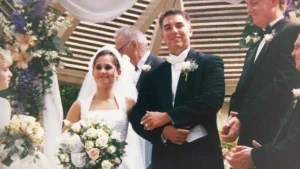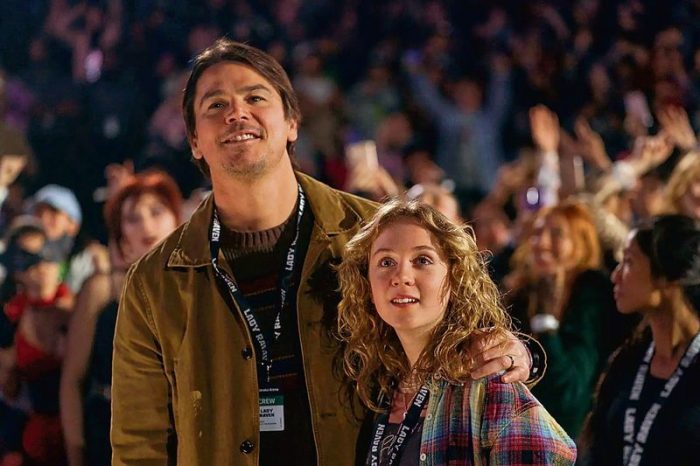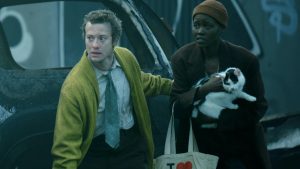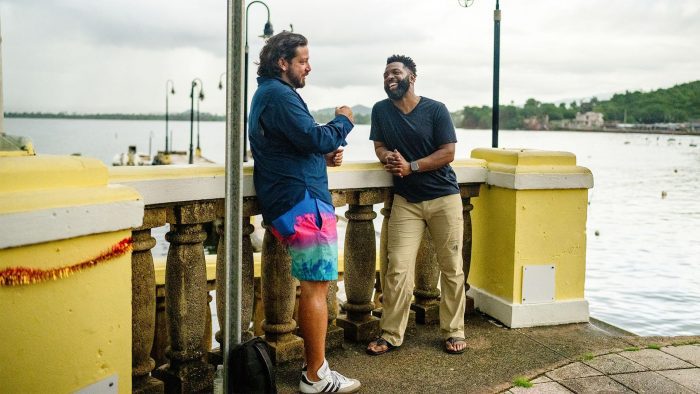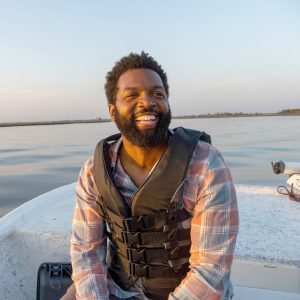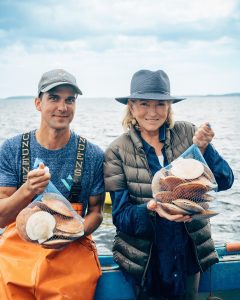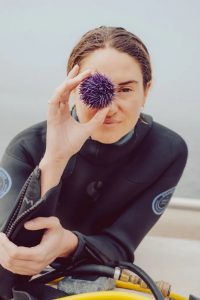Reviewed by Jeffrey Sanzel
After nearly twenty years of high-profile performances (including multiple franchises), actor Zoë Kravitz makes a first-rate directorial debut with Blink Twice.

Photo by Carlos Somonte, Amazon MGM Studios
Kravitz collaborated on the screenplay with E.T. Feigenbaum, a writer from her 2020 Hulu series, High Fidelity. They have created an interesting, edgy, slightly over-long film that nods to The Most Dangerous Game and, more recently, The Hunt. Blink Twice focuses on intertwining issues of memory and power, but the foremost thread is the abuse of women—specifically by rich, white men. While in this context taken to the extreme, the film makes the point no less honest and valuable.
The opening image of Frida (Naomi Ackie) scrolling through her phone while sitting on the commode perfectly presents her dead-end life. “I need a f— vacation,” she says. This prescient statement provides layers of pay-off.
She and her best friend, Jess (Arrested Development’s Alia Shawkat, in a grounded performance), cater-wait at tech billionaire Slater King’s (Channing Tatum) pretentious high-end gala. After a “meet cute”—that is anything but—King invites the pair to his island. Arriving by private jet, the entourage of King and his buddies and a gathering of young, attractive women land in paradise for days of eating, drinking, bathing, and drugs. Literally, there is “a tsunami of champagne.”
Stripped of any outside world connection (including the ubiquitous cell phones), continual and unchecked hedonism ensues. The unbridled existence is emphasized by the women’s apparel, diaphanous white dresses provided by their host; these further King’s bacchanalian environment. For nearly forty minutes, Kravitz presents endless days of relaxation, meals of detailed extremes, and nights of excess.
While the view of no one wanting the trip to end, Frida’s reality begins to jar. The new refrain is that “something is wrong with this place.” This, coupled with the idea that the ability to forget is a gift, spurs the latter half of the film. Indigenous serpents, mysterious perfume, and the shadowy natives serving the guests become increasingly important. The turning point is Jess being bitten by one of the snakes. The film kicks into high gear, building to terrible revelations in the final twenty minutes. The violence is appropriately brutal and relentless and cannot be unseen.
While the plot has been explored in various incarnations, Kravitz shows great skill, imbuing every scene with low-boiling tension. Even the brightest sunlight and the clearest swimming pool project an atmosphere of dread. She employs often-trod tropes—a creaking door, a stack of hidden Polaroids, a particularly sharp knife—but nothing seems gratuitous. Even the omnipresent red gift bags project a menace.

Ackie beautifully arcs Frida from uncomfortably passive to a resourceful and righteous warrior. She is matched by the extraordinary Arida Arjona, as Sarah, a C-list celebrity from a “babes-as-survivors” reality show. The adversarial relationship underlies the point that society pits women against women. When the situation shifts, so does their dynamic; together, they own the film’s final stretch. Tatum (in seemingly Brad Pitt mode) is appropriately slimy, if a bit obvious, as the mogul. However, his take on forgiveness provides a brief but pointedly disturbing monologue; he is also effective in King’s flashes of doubt.
The supporting cast, including Simon Rex, Liz Cabel, Levon Hawke, Trew Mullen, and Haley Joel Osment, serve their functions and play the few notes provided with ease and abandonment. Christian Slater turns in a familiar performance. Likewise, Kyle MacLachlan’s cameo as King’s therapist harkens to much of the actor’s earlier work. However, Geena Davis, as put-upon assistant Stacy, has one of the most memorable and alarming moments in the entire film.
Blink Twice’s original title directly referenced the #MeToo movement, but presenters balked, and Kravitz changed the title to the more benign moniker. While initially resisting, she eventually embraced the reality that “we’re not there yet. And I think that’s something I have the responsibility as a filmmaker to listen to.”
While the film would have benefited from judicious cuts to the one-hundred-and-fifty-minute running time, Adam Newport-Berra’s exceptional camera work and Kravitz’s smart, taught direction build to a thrilling climax. She slyly introduces gallows humor when the story turns darkest, and her resolution borders on brilliant.
While Blink Twice is not perfect, it is strong, riveting, and significant. It also heralds Kravitz as a significant new filmmaker who earns the titles of up-and-coming and accomplished.
Rated R, the film is now playing in local theaters.



